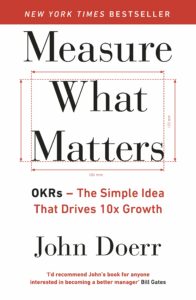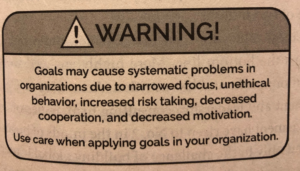This book, written by John Doerr, is a management Bible that talks about nothing but common sense. Simplicity, when communicated effectively, is infectious! The fundamental premise of this book lies in the fact that Ideas are easy, Execution is everything. John Doerr having worked at Intel imbibed this philosophy from Andy Grove (Intel) & then went on to become early investor in Google. He then helped successfully implement OKRs in multiple organisations ranging from Google to Zume Pizza to Bill & Melinda Gates Foundation to Adobe and many more! Below is my interpretation of the book –

OKR (Objective & Key Result) – a collaborative goal setting protocol for companies, teams and individuals. They cannot substitute for sound judgement, strong leadership, or a creative workplace culture. But if those fundamentals are in place, OKRs can guide you to mountaintop
- Definition
- Objective – simply WHAT is to be achieved, no more and no less
- Key Results – benchmark and monitor HOW we get to the objective. Effective KRs are specific and time bound, aggressive yet realistic. Most of all, they are measurable and verifiable
- Eg: Intel in 1971 – O: “we want to dominate the mid range microcomputer business”. KR: “win 10 new designs for 8085” (easily measurable)

- On assembly line it is easy enough to distinguish output from activity. It gets trickier when employees are paid to think
- It was liberating too (pasting your OKRs on your desk). When people came to me mid quarter with requests to draft new data sheets, I felt I could say no without fear of repercussion
- OKR superpowers (that it brings to the table)
-
- Focus
- Alignment
- Tracking
- Stretching
- Andy Grove said, “if the vectors point in different directions, they all add up to zero. But if you get everybody pointing in the same direction, you maximise the results”
- I can’t tell you how many times I’ve seen people walk out of meetings saying, “ I’m going to conquer the world”… and 3 months later, nothing has happened. You get people whipped up with enthusiasm, but they don’t know what to do with it
- Jeff Weiner: “When you’re tired of saying it, people are starting to hear it”. It just can’t stop with unveiling top line OKRs at a quarterly all hands meeting
- The more over ambitious the OKR, the greater the risk of overlooking a vital criterion. To safeguard quality while pushing for quantitative deliverables, one solution is to pair key results – Measure both Effects and Counter-effects
- You need to build your goal muscle gradually, incrementally. Doing too much too soon will definitely end in pain

- The more challenging an objective, the more tempting it may be to abandon it. Commit!
- At any given time, some significant % of people are working on the wrong things. The challenge is knowing which ones. Research shows public goals are more likely to be attained than privately held ones. Transparency seeds collaboration
- Ill effects of a pure Top Down approach: When all objectives are cascaded, process degraded into a mechanical exercise with 4 adverse effects –
- loss of agility
- lack of flexibility
- marginalised contributors
- one dimensional linkages
- Even a 100% Bottoms up approach isn’t ideal. A healthy OKR environment strikes a balance between alignment and autonomy, common purpose and creative latitude. Mix of bottom up and top down remains half and half
- OKRs are not islands. To the contrary, they create networks – vertical, horizontal, diagonal – to connect an organisation’s most vital network
- One underrated virtue of OKRs is that they can be tracked, revised or adapted as circumstances dictate unlike traditional frozen “set them and forget them” business goals. OKRs are living, breathing organisms with phases –
- the setup
- OKR Shepherd(someone to drive universal adoption)
- midlife tracking (single greatest motivator is making progress in one’s work)
- wrap up: rinse and repeat (score, assessment and reflection)
- A mission is directional. An objective has a set of concrete steps that you’re engaged in and actually trying to go for. Don’t confuse the two
- Without frequent status updates, goals slide into irrelevance; the gap between plan and reality widens by the day
- We do not learn from experience, we learn from reflecting on experience
- If companies don’t continue to innovate (not iterate), they’ll die (Stretch OKRs are a must)
- Stretch goals cannot seem like a long march to nowhere. Stretch your team too fast and too far, and it may snap. Leaders must convey two things – importance of the outcome and the belief that it’s attainable
- The annual appraisal cycle is mostly futile due to recency bias, bell curve and rankings. Quarterly review of OKRs makes this redundant. New process of continuous performance management is achieved by – C (conversations), F (feedback) and R (recognition)
- The key part to implementing OKRs and CFRs is decoupling compensation (both raise and bonus) from OKRs. This system has 3 key requirements –
- executive support
- clarity on company objectives and how they align with individual priorities (OKRs)
- investment in training to equip managers and leaders to be more effective
- Culture, as the saying goes, eats strategy for breakfast. Companies that out behave their competition will also outperform them
Do share your views/feedback in the comments section
I wanted to write you one little bit of observation to be able to say thanks again on your magnificent knowledge you have contributed above. It is really extremely open-handed with you to give freely precisely what most of us would’ve offered as an e-book to help make some bucks for their own end, principally considering the fact that you could possibly have done it in case you desired. These inspiring ideas likewise served as a fantastic way to understand that some people have the same dreams much like my own to find out significantly more related to this issue. Certainly there are several more enjoyable moments in the future for many who start reading your website.